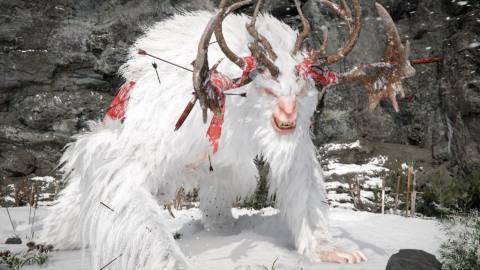
With one of the game industry’s most popular MMOs, Black Desert Online, under its belt, developer Pearl Abyss is shifting to a single-player open-world action game with Crimson Desert. As someone who dabbled with Black Desert but lacked the dedication to stick with it, I’ve been looking forward to Crimson Desert’s solo-minded approach and I enthusiastically embarked on a hands-on slice of the game during Gamescom. Yet while Crimson Desert teems with dangerous, mythical threats, my fiercest opponent reared its head on a systems level.
Crimson Desert unfolds on the vast continent of Pywel and puts players in the bloodstained shoes of brooding mercenary Kliff. A band of fellow swords-for-hire accompanies Kilff on his mission to save this beleaguered land, though I didn’t see much of it in the Gamescom demo, which focused on melee action via four selectable boss fights.

Check out Polygon’s Gamescom 2024 hub page for all our coverage of the world’s biggest games event.
Although Crimson Desert’s vibe evokes the gritty fantasy of Game of Thrones (and Kliff heavily resembles Jon Snow with face paint), its gameplay comes across more playful. Imagine combining fast-paced hack-’n-slash action with WWE 2K grappling and a dash of monster scaling à la Dragon’s Dogma or Monster Hunter. Kliff can hack apart foes by stringing together melee combos using his sword or weapons the enemies drop. Hilariously, he can also execute a range of pro wrestling moves, from a running dropkick to a giant swing to even a straight-up RKO.
Kliff also boasts maneuverability in the form of the Crow’s Wing, essentially a glider that aids in traversal. A precision focus ability slows time, allowing him to carefully pick off targets using his bow. He can climb atop larger adversaries and stab weak points to bring beasts to their knees. Pearl Abyss has gone out of its way to make every swing, slice, and impalement look cool, as nearly every big attack produces a shower of colorful particle effects.
Each of the four boss battles in the Gamescom demo offered a distinct challenge. I tackled the Staglord first, a sword and shield-bearing lord who provided a relatively easy and straightforward challenge. The second boss, a speedy scarecrow-like masked menace called the Reed Devil, proved the most maddening foe. His ability to quickly dart around a wheat field and take potshots from afar meant keeping him in view was disorienting. When I got him in my crosshairs, he often struck first or changed position. The windows of opportunity to retaliate seemed small, and since most attacks caused Kliff to leave his feet, simply recovering meant losing the chance to retaliate.
The battle against White Horn, a yeti-like beast sporting massive horns, was reminiscent of facing the Great Ape in Sekiro. This monster threw himself at me with a wild and unpredictable melee assault. He also unleashed ice storms that froze Kliff in place, leaving me vulnerable to attack. I found success with a more hit-and-run defense to stay out of his sizeable reach for as long as possible. The final foe, the Queen Stoneback Crab, was a giant crab made of rock. This battle channels Shadow of the Colossus, requiring players to scale a crystal-laden shell to attack weak points that will presumably bring it to its knees. I say “presumably” because, unfortunately, my hour-long session concluded before I could see this fight to its conclusion.
Each boss sports a more powerful second phase, though Kliff can hang in there thanks to a Sekiro-like second chance to pop back up and resume the battle. I made copious use of this mechanic because each battle presented a steep challenge. But the most irritating obstacle often wasn’t the White Horn’s debilitating blizzards or the Reed Devil’s dizzying speed. Instead, my toughest trial came from trying to keep my targets on screen.
My biggest criticism of Crimson Desert’s Gamescom demo was the lack of lock-on targeting (or the kinds of adjustments needed without it) led to issues that hampered the fun. The game seems inspired by Monster Hunter in this respect, but the enemies often outmaneuvered Kliff in a manner that turned battles into an annoying exercise of rotating the camera to keep opponents in view. The overabundance of particle effects also cluttered the screen and made it hard to parse what was happening, making a lock-on feel even more necessary. Blocking was similarly tricky to nail down. I’d have Kliff’s defense primed only for attacks to barrel through, seemingly because I was a degree or so off in facing the enemy properly. I never found the timing or positioning sweet spot during my session, so defending often felt like a game of chance.
The camera became a nuisance, as well. Kliff’s movements have a ragdoll-like quality especially when he’s knocked airborne, and many attacks sent him careening into walls, over cliffs, or straight into the camera like he was knocked out of a Super Smash Bros. arena. Though this was amusing, the camera tended to go haywire during these instances and failed to keep Kliff squarely in view, resulting in zoomed-in shots of him downed in a corner, with little to no view of the surrounding threats. It didn’t help that when Kliff fell prone, he was susceptible to being ganged up on and stun-locked into oblivion. I suffered several frustrating deaths due to getting stomped into the dirt while desperately trying to reorient the camera and get to my feet.
Because of these issues, I walked away from my session filled with cautious optimism. Crimson Desert’s combat showed flashes of fun, but in the demo it became too chaotic for its own good, occasionally devolving into a full-on mess. I’m hoping these issues will be ironed out because there’s significant potential underneath those sore spots. It remains to be seen if the open-world exploration portion of the game will hold up its end of the bargain, but I’m hoping Pearl Abyss tightens up the action before Crimson Desert launches next year.
